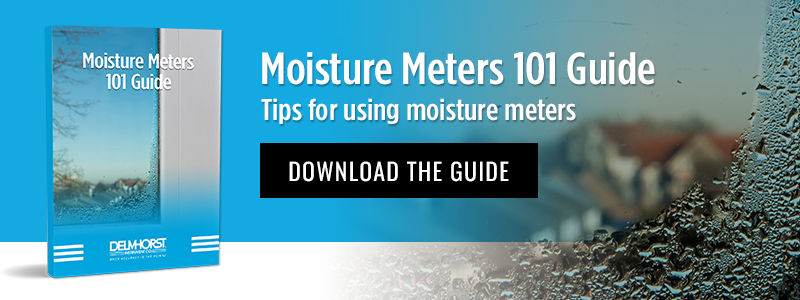When it comes to leaks in a structure, whether that structure is an office or a home, finding the leak quickly is crucial. Leaks not only add to the cost of a utility bill— the water damage caused by moisture intrusion into the structure can require thousands of dollars of remediation and repair.
For many common leaks, finding and fixing the source of the problem is relatively straightforward. For example, a leaky faucet or shower head might require the tightening or replacement of a seal, and the source of the leak is in plain sight. However, not all leaks occur in simple, easy to reach or see spots. Sometimes, water intrusion occurs in places where you cannot immediately see it, such as behind a wall or in the ceiling, where the visible signs of a leak might not appear right away.
Moisture meters are a very helpful tool for detecting moisture in building materials and for finding leaks in a structure—even when the origin point may be out of sight. This is why restoration moisture meters are crucial tools for water damage remediation experts.
“How can I locate leaks with a moisture meter,” you ask? Some advice for how to locate leaks using moisture meters include:
How to Locate Leaks Leaks in Dry Plaster, Brick, and Concrete
Masonry materials such as dry plaster, brick, and concrete typically have very little moisture in them. Sometimes, when trying to locate leaks with a moisture meter in a reference scale mode, there is so little moisture that the meter cannot detect it.
Thankfully, if you find moisture in one of these materials, there’s a trick you can use to pinpoint the origin point of a leak. To pull it off, you’ll need the following:
-
A nail made of a ductile metal;
-
Insulated wire; and
-
A pin meter such as the BD-2100.
To start the process, drive the nail into the area of the masonry that you know to be wet. Then, attach the insulated wire to the nail and one of the moisture meter’s contact pins.
Once the wire is attached to one of the contact pins, apply the other pin to different parts of the wall where you suspect the leak may be originating from. If the pin meter gives a “wet” moisture reading response, the wall is wet between the two contact points. If the pin meter gives a “dry” response, the material is not in the path of a leak.
Repeat the test until you’ve identified the limit of the “wet” response area.
This handy water damage restoration trick should help you locate leaks with a moisture meter when checking masonry materials.
Finding Leaks in Insulation
When loosely-packed insulation gets wet, the moisture not only ruins the insulation’s ability to keep the temperature of a building stable— it becomes a potential hiding place for mold. Over time, the moisture trapped in insulation will begin to affect the structures that the insulation is in contact with and cause damage.
To test insulation, you will want to use a moisture meter with extended-length probes such as Delmhorst’s 21-E electrode with #608 pins, which are insulated pins that penetrate to 3 1/4” deep (6” penetration type pins are also available). Because only the tips of these pins are exposed, you’ll be able to easily identify just how deep into the insulation the moisture pocket goes.
While you might not have to tear down the whole wall to get at the insulation to start testing, you will need to drill two holes that are 3/16” in diameter and set one inch apart in your siding or drywall. Once the holes have been drilled, push the pins into the holes and start taking readings at different depths using the reference scale setting of your pin meter. The reference scale setting will give you a qualitative assessment of any moisture that is present in the material being tested.
When you’re finished taking moisture readings, seal the holes that were drilled with an appropriate filler.
Depending on the distribution of moisture in the insulation, you may be able to establish whether the moisture is the result of a leak or if it is caused by condensation. This, in turn, helps you better identify the risk of water damage or mold growth.
In side walls and roof insulation, moisture intrusion is generally the result of leaks in the roof or other structural defects in the side walls that allow water (such as from melting snow & ice) to penetrate the structure. During cold weather, water vapor in the air will condense, with some remaining trapped in the insulation.
Normally, if moisture intrusion comes from a pipe leak in the wall, you’ll see much higher concentrations of moisture below the pipe, with little moisture being present in material above the pipe.
When looking for a moisture meter to use for finding leaks in insulation or masonry materials, be sure to look for a pin-type meter that has a reference scale setting. While pinless moisture meters can be very useful, their need for a large, flat, solid surface of sufficient thickness can make them less than ideal for finding leaks in hard-to-reach areas, softer materials (such as insulation), and curved or uneven surfaces.
By locating leaks with a moisture meter, you can save time and money by letting your plumber or restoration professional know where the leak is coming from. The less time they spend looking for a leak to fix the water damage, the lower your cost for labor will be.
To learn more about how to locate leaks with a moisture meter and how moisture testing devices work, check out Delmhorst’s Moisture Meters 101 guide using the link below.

Comments